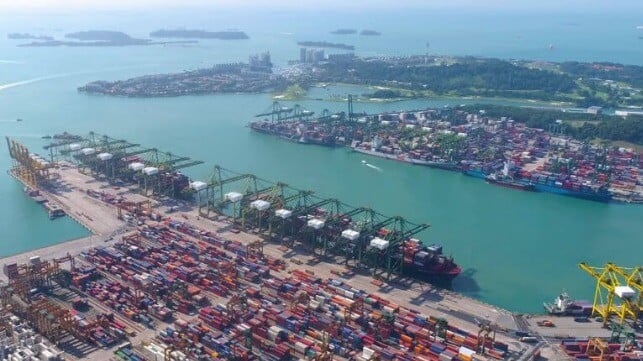Risk Study Sets Framework for Pilot Ammonia Bunkering in Singapore

Singapore will be site of the first large-scale pilot project testing ship-to-ship and other means for transferring and handling ammonia as a marine fuel. The pilot is set to proceed based on a report released today by the Global Centre for Maritime Decacbonisation (GCMD) which working with DNV and other partners finds the risk are low and manageable to proceed with ammonia as a marine fuel.
The nine-month study launched in January 2022 by GCMD working with DNV and supported by consulting firm Surbana Jurong and the Singapore Maritime Academy, analyzed the capacity and feasible operating concepts for ammonia bunkering. Despite the toxicity and associated risks, the study proceeded based on the recognition of green ammonia emerging as one of the leading alternatives for maritime decarbonization. The study concludes after extensive research that the risks for conducting pilots in the Port of Singapore were low or mitigable.
GCMD said that it is aiming for the first transfer of ammonia to take place by the end of 2023, subject to obtaining approvals from the regulatory agencies. They anticipate the pilot projects will take place at three locations identified in the research. Since ammonia-fueled vessels are not yet available, Professor Lynn Loo, CEO of GCMD, said the pilot will be conducted with proxy assets to gain competence and confidence so an actual bunkering exercise can commence when ammonia-fueled vessels are available.
“This project will help lay the safety considerations for ammonia bunkering,” said Knut Ørbeck-Nilssen, CEO of DNV Maritime. “Safety lies at the heart of the guidelines that DNV helped to develop for this pilot in Singapore. Further pilots and studies are key to understand, assess, and mitigate safety risks associated with using ammonia fuel onboard the world fleet.”
During the study, which produced the safety and operational guidelines for the pilot project, GCMD reports that more than 400 potential risks were identified and assessed based on breakbulk and bunkering at anchorage, shore-to-ship transfer, and cross-dock transfer. The DNV consortium consulted with 22 partners and obtained feedback from more than 130 industry and panel members. The study recommends suitable sites for pilots, and identifies hazards, key risks, and mitigation measures.
The report also estimated the total capital expenditure for the additional infrastructure buildout needed to operationalize ammonia bunkering at two land-based sites in the port.

that matters most
Get the latest maritime news delivered to your inbox daily.
In preparation for the next phase of the project, GCMD reports it is also working with the Singapore Maritime Academy to develop the framework for training operators to handle ammonia as a marine fuel. They report that the academy already conducted a first training course in March 2023 and is moving forward with additional training programs.
Moving forward with the pilot program is seen as a key step to preparing the world’s largest bunker port for the introduction of ammonia as a marine fuel. They point out that more than 1,000 ships a day move through the port requiring stringent guidelines. They believe the project will provide critical experience that can be used in Singapore and elsewhere to prepare for the adoption of the alternative fuel.
